|
 |  |
 April 1, 2002
In Israel's military campaign to hunt down Palestinian terrorists, tanks
surround the West Bank Palestinian town of Bethlehem.
 |  |  |
|
 |
|
 |  |
 April 2
Israeli warplanes, tanks, and troops launch a major ground and air attack on
Bethlehem. Heavy fighting breaks out in the streets of the Old City behind
Manger Square as Israeli soldiers enter homes and religious buildings in search
of militants.

Approximately 200 Palestinians fleeing from Israeli troops break into the
compound around the Church of the Nativity. Around 60 priests, monks and nuns
who live in the church compound are trapped inside with Palestinian civilians
and gunmen--among them, several heavily armed militia members, including
Ibrahim Abayat and Jihad Ja'arie of the Al Aqsa Brigade.
The militants had sought refuge in the Square near the church thinking Israel
would not fight so close to a Christian holy site. (The fourth century Church
of the Nativity was built over the site where Christians believe Jesus was
born; it is one of Christianity's most sacred places. Today the church compound
is managed jointly by three different Christian groups: the Armenian Church,
the Roman Catholic Church, and the Greek Orthodox Church.)
 |  |  |
|
 |
|
 |  |
 April 3
The standoff begins. The Palestinians holed up in the church are surrounded
by Israeli forces. At first, the trapped Palestinians eat food stored by the
monks and nuns who live there; over the next few weeks, conditions deteriorate
as food and water run out and all but one line of electricity is cut off.
 |  |  |
|
 |
|
 |  |
 April 4
Samir Ibrahim Salman, the church bellringer, is shot dead by Israeli snipers
when he runs out of the church. An Israeli spokesman later says the sniper
fired when Salman appeared to be ignoring shouted orders to stop; they feared
that he might be a suicide bomber.
 |  |  |
|
 |
|
 |  |
 April 5
Four Franciscan priests come out of the church and leave Bethlehem under
Israeli escort. Israeli army spokesmen say statements made by the priests
indicate that the clergy in the church are being held hostage by the
Palestinian militants; a spokesman for the Franciscan order told reporters that
the clergy inside were "voluntary hostages" who were remaining in the church to
show solidarity with the trapped Palestinians and because they believed that
their presence in the church would help avoid further bloodshed.
 |  |  |
|
 |
|
 |  |
 April 8
The Vatican calls on Israel to respect holy sites and demands an explanation
for the fighting around the church. Israeli President Moshe Katsav replies the
next day with a letter to the Pope saying that Israel will continue the siege
until the Palestinian gunmen surrender.
Gunfire damages the exterior of the church and starts a fire in an adjoining
building. One Palestinian is killed and two Israeli soldiers wounded in the
gun battle; each side claims the other fired first.
 |  |  |
|
 |
|
 |  |
 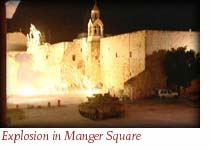 April 10
April 10
An Armenian monk is shot and seriously wounded by the Israelis; the next day,
an Israeli military official says the soldier mistook the monk for a
Palestinian gunman.
Israel ratchets up the pressure on the Palestinians. It sends a blimp fitted
with surveillance cameras above Manger Square and sets off a number of loud but
harmless explosions. Over loudspeakers, the Israelis call on Palestinians to
surrender and broadcast sirens and other noises.
 |  |  |
|
 |
|
 |  |
 April 12
The Christian Franciscan order appeals to Israel to release the Palestinians
and to provide water and power to the clerics trapped with them.
 |  |  |
|
 |
|
 |  |
 April 14
Israeli prime minister Ariel Sharon says that the trapped gunmen have a choice
of either facing trial in Israel or accepting permanent exile. The Palestinians
refuse.
More gunfire is exchanged. A Palestinian is shot and killed; an army spokesman
says he was armed and preparing to shoot at the Israeli troops.
 |  |  |
|
 |
|
 |  |
 April 17
A Palestinian leaves the church and is shot and wounded by Israeli soldiers
and later taken to a hospital for treatment. A sick priest is also evacuated to
the hospital.
 |  |  |
|
 |
|
 |  |
 April 18
Israel cancels scheduled negotiations to end the standoff, according to
Bethlehem Mayor Hanna Nasser.
 |  |  |
|
 |
|
 |  |
 April 20
A Palestinian negotiator tells reporters that food and water in the church have
run out.
Five Palestinians escape down ladders left leaning against a church wall by
Israeli soldiers.
 |  |  |
|
 |
|
 |  |
 April 23
The first round of face to face negotiations to end the standoff begins in the
Peace Centre across Manger Square from the church. The Israeli team is led by
Lt. Colonel Lior, the Palestinians by former PLO commander Salah Taamri. The
first day, it seems neither side will compromise: the Israelis reiterate
Sharon's demand that the gunmen on Israel's wanted list face either trial in
Israel or deportation, while the Palestinians insist that the wanted men should
be sent to Gaza for Palestinian judicial proceedings.
Three priests leave the compound.
 |  |  |
|
 |
|
 |  |
 April 24
Two Palestinians inside the compound are shot by Israeli snipers; one later
dies from his wounds. Two unarmed Palestinians surrender to Israeli forces,
saying they are sick. Army spokesmen say the men are members of Palestinian
security forces.
In the second day of negotiations, the two sides forge their first deal. The
Israelis agree that the decomposing remains of two Palestinians killed earlier
in the siege may be removed from the compound; in exchange, the Palestinians
will allow a group of teenagers to leave.
 |  |  |
|
 |
|
 |  |
 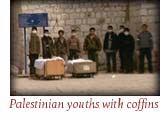 April 25
April 25
Nine Palestinian youths emerge from the church carrying the corpses of two
Palestinian policemen in homemade coffins. Israeli forces question the youths
and then release all but one of them to their homes. One was detained by
secret security because he was suspected of planting explosives in Jerusalem,
according to Israeli negotiator Lt. Colonel Lior.
 |  |  |
|
 |
|
 |  |
 April 26
Four Palestinian policemen surrender to Israeli troops; two Palestinians inside
the compound are wounded by Israeli sniper fire and evacuated for medical
treatment.
 |  |  |
|
 |
|
 |  |
 April 27
The Palestinian delegation returns from a meeting with Palestinian leader Yasir
Arafat and are ready to make a "food for people" deal. Palestinian
representative Salah Taamri offers to go in and speak to those in the church
about the fate of the men wanted by Israel and to try and convince those inside
to release a group of innocent civilians in exchange for food. By this time,
stocks of food inside the church are long gone and people now are eating plants
growing in the courtyard.
 |  |  |
|
 |
|
 |  |
 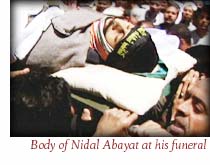 April 29
April 29
In Ramallah, a similar siege on Yasir Arafat's compound ends with six men on
Israel's wanted list released into Palestinian custody. Israeli negotiators
realize that their mandate to fight for Israeli jail or deportation for the men
wanted in Bethlehem is likely no longer in force. This Ramallah agreement
inspires Palestinian negotiators to call for a similar deal for the wanted men
in the church.
Palestinian militia leader Nidal Abayat--one of the men on Israel's most wanted
list-- is killed by an Israeli sniper in the church courtyard. Palestinian
negotiators break off talks. Isrealis say Abayat was firing an automatic weapon
from within the church.
 |  |  |
|
 |
|
 |  |
 April 30
Twenty-four Palestinians leave the church as part of the "food for people" deal
brokered by Lt. Colonel Lior, but the food is not delivered. The authority of
the Israeli negotiating team has been usurped by separate negotiations taking
place between Israeli and American politicians. According to Lt. Colonel Lior,
the Israeli strategy shifts "from negotiati[ng] to agreement as a primary
tactic, to block[ing] the area and increas[ing] the pressure as a primary
tactic."
 |  |  |
|
 |
|
 |  |
 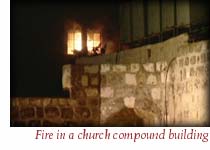 May 1
May 1
Fire breaks out in buildings adjacent to the church compound after a heavy
exchange of gunfire. The video is broadcast around the world. Both sides blame
the other for starting the blazes, which are extinguished within the hour. The
international press is invited back to Manger Square by the Israelis in an
attempt to minimize PR damage.
 |  |  |
|
 |
|
 |  |
  May 2 May 2
Dodging Israeli gunfire, a group of international peace activists bringing
food, and a Los Angeles Times photographer, sneak into the church. Once
inside, they describe the deteriorating conditions to reporters by telephone,
saying people have only grass and leaves for food.
Negotiations take on political urgency. There is mounting U.S. pressure for a
deal prior to a scheduled meeting between U.S. President George W. Bush and
Israeli Prime Minister Ariel Sharon. The Israeli negotiating team on the
ground is informed that their mission is over.
Gun battles around the church continue. An armed Palestinian is shot dead by
Israeli troops; two others are severely wounded.
 |  |  |
|
 |
|
 |  |
 May 3
Three sick and exhausted Palestinian policemen emerge from the church and are
taken into Israeli custody.
 |  |  |
|
 |
|
 |  |
 May 5
Negotiations intensify when American representatives, as well as top aides to
Palestinian leader Yasser Arafat, join the talks. CIA agents arrive in Manger
Square accompanying a delegation of high ranking Palestinians under orders from
Yasser Arafat to release a list of those in the compound.
Israeli troops shoot and kill an armed Palestinian in the compound.
 |  |  |
|
 |
|
 |  |
 May 6
A tentative deal, brokered by the U.S., is reached: the Palestinian fighters
will be released, with those considered by Israel to be the most dangerous
going into exile in Europe, most likely in Italy, those less wanted released
into Palestinian custody in Gaza. The rest would go free.
 |  |  |
|
 |
|
 |  |
 May 7
Italy refuses to take all the exiles, thwarting the deal.
 |  |  |
|
 |
|
 |  |
 May 9
Cyprus says it will take the 13 men on Israel's most wanted list temporarily
while a decision is made on their ultimate destination.
 |  |  |
|
 |
|
 |  |
 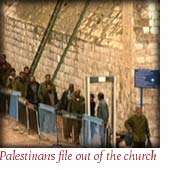 May 10
May 10
The siege ends; all Palestinians leave the church. The 13 most wanted men,
including Ibrahim Abayat, are flown to Cyprus; 26 others, banished from
the West Bank, are taken to Gaza.
 |  |  |
|
 |
|
 |  |
 May 22
European Union negotiators finalize the arrangements for 12 of the exiled
Palestinians: three will go to Italy, three to Spain, two each to Greece and
Ireland, and one each to Belgium and Portugal. They will initially receive a
one year temporary residence permit in their host countries. The thirteenth
Palestinian, believed by Israel to be the most dangerous and the leader of the
militants during the siege, will remain in Cyprus until a country is found that
will accept him.
 |  |  |
|